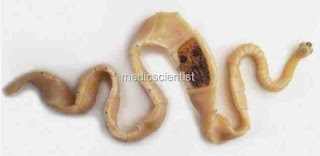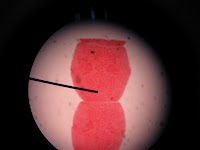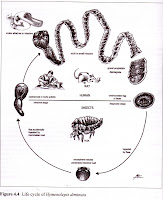Cestodes
Class Cestoda:
General Characteristics
- bothria (slit like grooves on grooves on the scolex)
- Usually quite large
- genital pores may be laterally or centrally located
- vitellaria and testes are numerous
Diphyllobothrium latum- the “broad fish tapeworm” of humans
 /
/
Taenia Saginata
1) Taenia Saginata; beef tapeworm
- The scolex has 4 suckers but no hooks. ( refer figure 2.0 > b )
- measure approximately 5cm and 3 cm respectively.
- proglottids; greater than 1000 & measures approximately 17 x 5 mm & has 15 - 25 lateral uterine branches on each side of the uterus.
- Spherical to oval eggs & radially striated with a yellowish, brown shell, measures approximately 30 - 40 μm & also has six-hooked oncosphere in embryonated eggs.
T.solium


.JPG) Like all members of the Cestoda, T.solium lacks a digestive system, and feeds by absorbing nutrients (in the form of carbohydrates) from the digestive system of its host across its membrane. This requires T.solium to maximize its surface area: volume ratio. T. solium has adapted in several ways to accomplish this goal. The tapeworm has a flattened body, which maximizes the area available for nutrient absorption while minimizing the volume these nutrients must travel to reach each of the organism’s cells. Cestodes also have microtriches, which are tiny projections that cover the entire body. These serve to increase the surface area even more.
Like all members of the Cestoda, T.solium lacks a digestive system, and feeds by absorbing nutrients (in the form of carbohydrates) from the digestive system of its host across its membrane. This requires T.solium to maximize its surface area: volume ratio. T. solium has adapted in several ways to accomplish this goal. The tapeworm has a flattened body, which maximizes the area available for nutrient absorption while minimizing the volume these nutrients must travel to reach each of the organism’s cells. Cestodes also have microtriches, which are tiny projections that cover the entire body. These serve to increase the surface area even more.
Another way T.solium gains nutrients is through secretions which make the digestive system more acidic. The lowered pH helps T.solium be more efficient at absorbing carbohydrates.

.JPG) Taenia solium is commonly referred to as the pork tapeworm. Humans harbor the adult worm and pigs serve as the intermediate host. Egg capsules from human stools contaminate vegetation which pigs may eat. The egg capsules contain an oncosphere or hexacanth larva which when ingested by pigs, develops into a cysticercus, otherwise known as a bladderworm, usually in the muscles of the pig. If pork is eaten poorly cooked, the cysticercus evaginates its scolex in the duodenum and grows into an adult up to ten meters long. Pigs cooked by amateur barbecuers may serve as a source of infection. If humans accidentally ingest the egg capsules, cysticerci or bladderworms will develop in a variety of vital organs including the the brain, eye, heart, lungs and liver, interrupting function. This condition is known as cysticercosis, causing this worm to be the most dangerous of the human tapeworms. A single person who is infected may contaminate his/her surroundings posing a danger to others. Infected farm workers defecating in the field may contaminate a crop which then may serve as a source of infection for humans as well as pigs. Contaminated maids and cooks may inadvertently infect members of the household they serve.
Taenia solium is commonly referred to as the pork tapeworm. Humans harbor the adult worm and pigs serve as the intermediate host. Egg capsules from human stools contaminate vegetation which pigs may eat. The egg capsules contain an oncosphere or hexacanth larva which when ingested by pigs, develops into a cysticercus, otherwise known as a bladderworm, usually in the muscles of the pig. If pork is eaten poorly cooked, the cysticercus evaginates its scolex in the duodenum and grows into an adult up to ten meters long. Pigs cooked by amateur barbecuers may serve as a source of infection. If humans accidentally ingest the egg capsules, cysticerci or bladderworms will develop in a variety of vital organs including the the brain, eye, heart, lungs and liver, interrupting function. This condition is known as cysticercosis, causing this worm to be the most dangerous of the human tapeworms. A single person who is infected may contaminate his/her surroundings posing a danger to others. Infected farm workers defecating in the field may contaminate a crop which then may serve as a source of infection for humans as well as pigs. Contaminated maids and cooks may inadvertently infect members of the household they serve.
2) Taenia Solium; pork tape worm
- The scolex has a restellum with 2 rows of hooks plus 4 suckers. ( refer figure 2.0 > a )
- measure approximately 5cm and 3 cm respectively.
- proglottids; fewer than 1000 & has 7 - 14 lateral uterine branches.
- Spherical to oval eggs & radially striated with a yellowish, brown shell, measures approximately 30 - 40 μm & also has six-hooked oncosphere in embryonated eggs.
Human infection with this both parasite by ingestion of uncooked beef or pork that containing the cysticercus larvae of this parasite. The larvae is digested out the meat in the stomach. The scolex of the larvae attaches to the mucosa of the small intestine & develop to adult worm. Eggs are produced, and passed in human feces than ingested by cows or pigs ( as intermediate host ). The onchosphere hatches from egg, and develops into the cysticercus larvae in the animals tissue.
If the eggs of Taenia Solium are accidentally ingested by humans ( acts as an intermediate host ). A condition known as cysticercosis may develop. The oncosphere develops and escapes from the eggs, and invades the body tissue, especially tissues and organs of nervous system ( maturation of adult worm does not occur ).
Transmission and Pathogenesis
1) Ingestion of raw or uncooked beef or pork contaminated with this both larvae.
2) Asymptomatic
3) Mild symptom; diarrhea, indigestion or abdominal pain.
4) Human ingestion of eggs of Taenia Solium;
- ingestion contamination food/ water with feces that contain Taenia Solium eggs.
- Cysticercus larvae may migrate to the brain and causing neurocysticercosis.
- May cause headache, seizures & also death.
Laboratory diagnosis
1) Finding gravid proglottids or eggs in human feces.
2) Computed tomographic ( CT ) scans.
3) Magnetic resonance imaging ( MRI ).
Treatment and prevention
1) Praziquantel and niclosamide as treatment.
2) Good sanitizing practice. 3) Cooking beef or pork.




.JPG)



.JPG)





.JPG)
.JPG)
.JPG)


.JPG)










